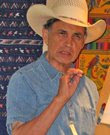George Flett Ledger Art Since 2007
In his interesting and well-informed introduction to George Flett: Ledger Art (New Media Ventures, 2007), Scott M. Thompson explains that, in the Spokane oral tradition, storytellers employed a variety of voices, gestures, pauses, and facial expressions. And he points out the specific ways Flett translates these dramatic conventions into his story-telling images. Indeed, what distinguishes this collection are the story-telling figures and subtitles that are implicitly in the past tense, and a written story that serves as a present retelling.
--For larger pictures and text, pull down View menu and choose larger text size, or click on "Ctr" and "+." "Ctr and "-" will decrease them. For Macs, click on the Apple key instead of Ctrl.

Story of the Prairie Chicken Dance
Flett’s "Story of the Prairie Chicken Dance" is a “thick” narrative of the dance’s origin. It is composed of three historical moments, or tenses, which take the viewer from the storytelling present (on the right), to the near past (in the center) as the listeners picture the prairie chicken dancers they have seen, to the origin of the dance, when one of the young men, watching some prairie chickens mating (in the scene below), was given the power to dance like them by his spirit helper (in the scene above it).
And the drawing (or Flett’s story) includes not only a temporal plane but a spiritual plane behind it—where the horse spirits flying above the tipi empower the storyteller, a prairie chicken spirit empowers the dancers of the near past, and the original prairie chicken spirit empowers the young man who watched the prairie chicken mating dance. (See "Prairie Chicken Dancers Dancing to the Horse Stealing Song.")
In contrast to the power conveyed in his story is the drawing’s mundane ground: the 1911 ledger page of William Gross’s account book, which ironizes the story. The irony becomes vivid when we notice the lively prairie chicken spirit, on the left-hand side of the page, sitting above the name of the very dead businessman.
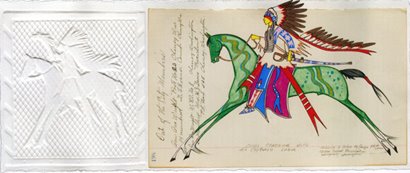
Comes Charging with His Captured Saber
Even more ironic is the relation between figure and ground in "Comes Charging with His Captured Saber." And here we may become aware of such irony’s ambivalence. For, Flett tells us, the saber in the drawing was passed down to his friend. And “when I hold that saber in my hands, I feel the power from the spirits around me.” The embossed image, which comes alive as the light changes, is his way of preserving and “passing on that power.” And this power is enhanced by Flett drawing his story on a page from the ledger book that was used since the 1890s to maintain a list of veterans who had been associated with the fort in Spokane, Washington, named after General George Wright. In 1858 Wright led the troop of soldiers that defeated the Spokane and their neighboring tribes at Liberty Lake. To punish them he ordered the slaughter of 800 captured horses over a period of two days.
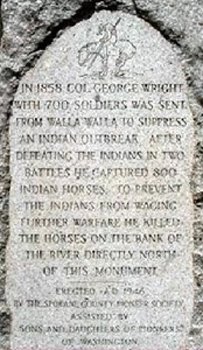
Monument to Col. George Wright
A monument sponsored by the Spokane Pioneer Society was erected at the Horse Slaughter camp in 1946. This monument, with its engraved image (top) modeled after James Fraser’s "End of the Trail," was meant to symbolize “the vanishing race.” This powerful drawing, then, undermines the myth, reclaims the period of American Indian power, and demonstrates the vitality of the Spokane people today. Nonetheless, the drawing’s power is balanced by the power of ledger books in general, which are still emblems of American capitalism, but particularly the ledger record of those who memorialized Spokane defeat. The ironic relation of the figure and ground, then, is always ambivalent.
Ledger art is what Michel de Certeau calls a “tactic”--an ordinary practice “that enable[s] disenfranchised and oppressed people to realize their variety of voices, maintain communities, and achieve practical kinds of power." Tactics, Certeau continues, “are opportunities seized on the wing, fragmentary and fragile victories of the 'weak' over the 'strong.' But the weak cannot keep what they win; rather they appropriate spaces of the dominant culture for their own uses--or make them 'habitable,' like a rented apartment.... [which] transforms another person's property into a space borrowed for a moment." But let us continue for a while in the borrowed space.
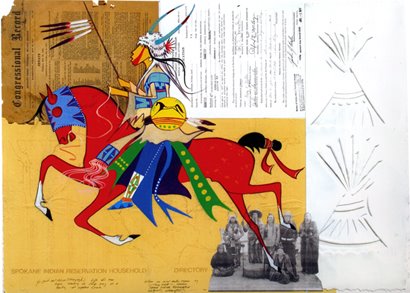
Lifts His Fan Before Dancing the Chief's Song at Oyaken Creek
Flett’s mixed media pieces enable him to preserve his family history in a series of overlapping temporal layers. "Lifts His Fan Before Dancing the Chief’s Song at Oyaken Creek" takes us back to the 1890s through 1910, when, Flett tells us, “there were. . . relatives who lived in the Oyaken Creek area on the Spokane Reservation. I can remember my mother telling me stories about these relatives. They would have their winter medicine dances or they might ride to various family locations out there, or maybe have meetings, or talk about, for example. . . . the reservation land allotments.”
But the drawing is not simply a family and tribal story. It forms a dynamic interplay of individual, tribal, and federal material histories. Three federal documents form the layered historic ground upon which Flett’s story is told: a federal map and household directory of the allotted Spokane Reservation, a 1977 notification from the Department of the Interior modifying an allotment, and a page from a 1931 Congressional Record.
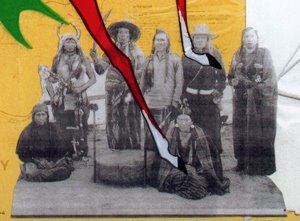
Detail from Lifts His Fan
Standing out from the layered ground of Western expansion, is a photo transfer of Flett’s ancestors— Shwin-whit (or John Stevens) and his family—which becomes a presence due to the three-dimensional pedestal that holds them (Stevens is on the top row, wearing the horn bonnet). And Strong Eagle, a colorful legendary warrior in his best attire, rides his masked and painted horse over the federal documents. The rider, also Flett’s ancestor, is connected to the Stevens family by the transparent style of the horse’s lower rear leg—which enables us to see the full figure behind it. And two embossed spirit tipis in the white matte behind them bring the spirit power of the historic Oyaken Creek households into the viewer’s present.

Spear in the Ground
"Spear in the Ground" contains a pictographic story of Flett’s maternal grandfather, who was left in a cradleboard leaning against a spear in the root-digging plains. Knowing that she could not take care of him, his mother had placed him on a regularly traveled route. She left when she heard someone coming, and the couple riding along the trail knew they were meant to take him.
The story is drawn in color pencils on a cash book page, which has been burned into the shape of a buffalo robe. Flett both appropriates this material record of Western expansion, using it to record his own individual/tribal history, and shapes the Western accounting page into a form of traditional native clothing. Moreover, he places the transformed cash book page upon a faded Department of the Interior geological survey map of the Spokane Reservation’s Turtle Lake area—the small part of the reservation left after the land allotments.
On the important right-hand side of the cash book page is a colored pencil image of the baby in his cradleboard, leaning against the spear. Underneath the spear is written what will become the baby’s Spokane name, “Spear in the Ground,” followed by his name glyph, a small penciled drawing of the spearhead. The couple who will raise him can be seen to the baby’s left, riding toward him along a well-traveled trail. Above the baby and to the right (providing another layer and point of view) is a small image of the hiding mother, looking down at the baby and at the same time picturing (in a thought picture to the left) the fight where her husband was killed by a cavalry soldier. A spiral of sacred smoke connects the baby to his father and the soldier who shot him.
Above the cash book page, layered over the map, is a bright yellow sun (the name “Spokane” means “Children of the Sun”). And, forming another layer in front of the sun, is another photographic transfer of John Stevens. Then, painted in bright colors on the foremost layer, the legendary tribal leader Strong Eagle gallops across the Turtle Lake area and over the cash book, the legs of his painted war horse spanning the map.
Finally, serving as a mat and frame for the multi-dimensional montage and pictographic story, is a blank ledger page. And typed on a panel in its large right-hand margin is the grandfather’s story, now retold by George Flett, which concludes: “It is not written but etched in my heart, and this is how I picture that moment. This painting depicts how it might have been. This is how I honor my maternal grandfather, ‘Spear in the Ground.’” The story is signed “George Flett—Spokan, Spokane Indian Reservation, Wellpinit, Washington.” And beneath his signature is the glyph of his “‘sumish,’ bull elk or buffalo.” Flett’s final “This” in “This is how I honor my maternal grandfather” may refer to a lightly penciled drawing below his narrative—of the baby in his cradle board, leaning on the spear. But it also refers to the layered, or multi-dimensional story. What we experience, then, is George Flett telling the story etched in his heart to honor his grandfather, which includes the tellings, retellings, and associated stories across three generations.

